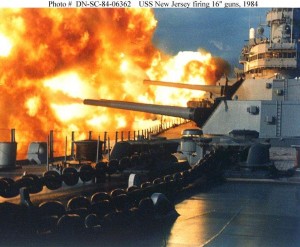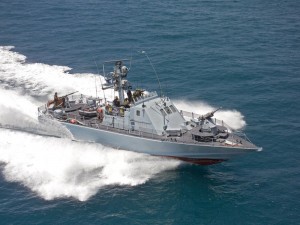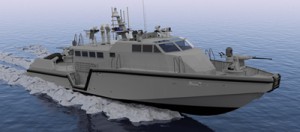 In America’s arcane and endless doctrinal debates over amphibious warfare (examples here and here), one constant shines above all–the incessant Marine Corps call for large-caliber fire support from the sea.
In America’s arcane and endless doctrinal debates over amphibious warfare (examples here and here), one constant shines above all–the incessant Marine Corps call for large-caliber fire support from the sea.
To “big gun” fire support advocates, the little “popguns” on America’s Littoral Combat Ships, Frigates, Destroyers and Cruisers don’t seem to matter at all in shore bombardment and are uniformly dismissed as ineffective.
That’s just wrongheaded propaganda.
Guns of any caliber are valuable. Now, everybody appreciates the utility of having a massively destructive gun “on call”, but, in North Korea, Vietnam–confrontations where America really demanded fire support–gun platforms came in all flavors–from the Iowa Class Battleships down to tiny destroyers and even smaller craft.
My underlying hypothesis is that, in those conflicts, the Marines and soldiers appreciated having whatever fire support the Navy could muster, regardless of caliber.
Large caliber guns do have a certain dramatic–and functional–appeal–what Marine wouldn’t want devastating 24/7 fire-for-effect support from a majestic grey-hulled battlewagon? (And, for that matter, what naval officer wouldn’t want a chance to command that majestic grey-hulled battlewagon?)
To that end–and after years and years of pestering–the United States is addressing Marine Corps concerns with three massive “littoral” DDG-1000s, which, despite the craft’s stated fire support mission, is going to be kept as far away from the littorals as is humanly possible–but, hey, what’s a few tens of billions of dollars (and a waaay too small a magazine) to shush up the Marine Corps, right? Right?
So…now that America has procured some “good and proper” larger-caliber fire support platforms, I suppose it might be a good time to ask if there are scenarios where large caliber fire support might be less-than-useful?
Are there coastal environments where fire support from smaller vessels is more appropriate and more effective? Urban environments? Places where collateral damage is a concern? Where World War II-era bombardments just don’t work?
Yes.
I’ll point to Gaza, where, again, just like in 2009, Israel is finding her tiny arsenal of all-weather naval guns (and missiles) militarily useful (well-publicized and tragic exceptions aside, of course). But it is my sense the doctrinarians of the High Church of Big-Caliber Naval Fire Support are–again–going to ignore some interesting lessons that Israel has learned in the waters off Gaza and Lebanon.
 The first lesson–something that we learned from PT Boats and promptly forgot–is that a well-armed small craft, supported by good sensors and ISR–can be quite useful. Try reading this 2009 account, from a reporter aboard a Shaldag–a tiny, 15-man aluminum speedboat.
The first lesson–something that we learned from PT Boats and promptly forgot–is that a well-armed small craft, supported by good sensors and ISR–can be quite useful. Try reading this 2009 account, from a reporter aboard a Shaldag–a tiny, 15-man aluminum speedboat.
“It’s the 13th night of Operation Cast Lead and we’re sailing on Yoni’s ship some 2.5 kilometers off the Gaza coast. It is the first time a reporter has joined naval forces since the start of the operation. From the ship, capable of up to 45 kilometers an hour, we see a Tarshish naval vessel, Sa’ar 4.5, which is also part of operations against Hamas.
Since the start of the military campaign, the bulk of the credit for hitting Hamas infrastructure has gone to the air force, which has conducted hundreds of sorties over Gaza. However, the navy has also been operating since the first day of the operation, and has hit some 200 Gaza targets with its various weapons.”
The second lesson is that, properly operated by an alert, ready crew, ships are still hard to hit:
The officer said that there had been attempts to fire at Israeli naval ships, mostly with light arms and anti-tank missiles…
…There have also been attempts by Palestinian boats to approach Israeli naval vessels, and the IDF suspects that they are trying to perpetrate a terror attack similar to that carried out on the USS Cole in Yemen in October 2000, when a small boat rammed into the vessel, blowing it up. There have also been attempts to smuggle arms via the sea into the Strip.
“All the time, there are attempts to approach us…they are dying to hurt us,” said the officer. “There is now a naval blockade so anyone who is in the sea is considered suspicious.”
A Shaldag carries little more than a 25mm Bushmaster cannon, and yet, there it is, 2.5 km from the coast, supporting ground operations, along with the rest of Israel’s innovative small boat fleet. And for those who scoff at the 25mm gun, i should remind you that smaller–quite, quite smaller–surface fires have been, ah, rather useful.
These little ships don’t just do shore bombardment either–they’re supporting a very active catalogue of amphibious operations. The Israeli Navy has pushed ahead with amphibious assault, buying LCTs (which I’ve written about before and, I might add, we hear precious little about) conducting landings on the Lebanon coast during both invasions, raids off Gaza for both invasions (naval commandos led the way this time), and commando work further afield.
 I am sure the IDF would relish a larger-caliber naval gun platform, but I would be willing to bet that the big gun’s utility would be somewhat limited in comparison to the smaller guns aboard Israel’s smaller platforms.
I am sure the IDF would relish a larger-caliber naval gun platform, but I would be willing to bet that the big gun’s utility would be somewhat limited in comparison to the smaller guns aboard Israel’s smaller platforms.
Modern naval warfare–in this era of tight budgets–is about having the right tools in the right place at the right time. Sometimes–and I think more times than the maritime taste-makers want to accept–a tiny scalpel, wielded by a well-trained, gutsy crew, is much more useful than just another grand-scale, “fire-for-effect” hammer.
That said, does the U.S. Navy have the apatite for this niche mission? Will the Navy support the provision of “low-end” fire support or will this be dismissed by a stressed Navy as an irrelevant luxury?

{ 11 comments… read them below or add one }
The best example of lethal small guns was the World War II LCS. The US Navy developed the Landing Class, Support (Large) to support landings in the Pacific. Based on LSI hulls, they were small (less than 400t, fully loaded), and slow (15.5kts top speed), but they were well-armed: 3″/50 main gun, 40mm and 20mm AA guns, and rocket launchers.
Basically, they were the exact opposite of the new LCS.
I loved those mighty mites. They were awesome.
Tiny guns are only useful if they’re used on tiny ships, and only if they get very, VERY close to the enemy.
The US Navy currently can’t wrap their brains around that concept at all, which is why they installed 57mm guns atop 3000-ton hulls — which by the standards of most nations are large enough to be considered Destroyers;
http://en.wikipedia.org/wiki/Littoral_combat_ship
Compare to the Ambassador Mk.III Missile Boat, which only weighs 500 tons (and like the LCS, is made in the US), but has a vastly more powerful 76mm gun;
http://www.naval-technology.com/projects/egyptian-navy-fast-missile-craft/
Finally, you confuse organic direct fire support with naval gunfire support. In the latter during the Vietnam War, the US Navy’s 5″ guns weren’t good enough, which is why they brought back Light Cruisers with 6″ guns. Those weren’t good enough either, resulting in the return of Heavy Cruisers with 8″ guns. The fact that Heavy Cruisers weren’t good enough is confirmed by the simple fact that in 1968, the US Navy sent a Battleship with 16″ guns to Vietnam.
And by every account, the BB-62 New Jersey was the final word on who won battles during her brief Vietnam tour. Hanoi was so frustrated by the damage they suffered by the guns of this single Battleship, that they actually demanded her removal from the theater as a condition for continuing peace talks with Saigon and Washington DC. No other US weapon ever elicited such a response during the Vietnam War, before or since.
Did the BBs do much at Korea? I’d love to sit down and see just what the 16 inchers actually did for the guys on the ground…
The Iowa class Battleships were extremely effective in the Korean War. Have a look;
http://en.wikipedia.org/wiki/USS_Iowa_%28BB-61%29#Korean_War_.281951.E2.80.931952.29
http://en.wikipedia.org/wiki/USS_New_Jersey_%28BB-62%29#The_Korean_War_.281950.E2.80.931953.29
http://en.wikipedia.org/wiki/USS_Missouri_%28BB-63%29#The_Korean_War_.281950.E2.80.931953.29
http://en.wikipedia.org/wiki/USS_Wisconsin_%28BB-64%29#World_War_II_.281944.E2.80.931945.29
Notably, the New Jersey was able to destroy five artillery sites near Wonsan on July 18th 1951, using five 16″ shells in a single fire mission — with no prior spotting or ranging shots. This was in support of ROKA operations in the area.
Totally agree about how we’re overlooking smaller systems–I’ve been a big fan of the LCM/LCU upgrade–either improvisational fires from embarked weapons or something a bit more permanent–like some of the neat Finnish/Swedish littoral experiments marrying mortars with small landing craft.
I think some are overlooking the new 120 mm auto mortars named NEMO or AMOS from Patria which have already been tested on coastat craft. They are very sophisticated and can be mounted on boats as small as LCVPs.
SInce the USN does NOT believe in close-in NSFS, they are completely ignoring that type of weapons system of which BTW that Marines are already using the rounds. Note the the largest weapon the new Mark VI PB will mount is a Mk 38 with maybe a small missile.
Given the current DDG inventory, I seriously doubt you will see one of those warships exposed to enemy fire~ Does anyone seriously believe that the LCS or their next-gen with be going NSFS?
The reason Marines have been “incessant” about large-caliber NGF is because the USN has “promised” that something is around the corner: in 1975, 1992, 2002, and today. A new weapon was always in the pipeline: the Mk-71 8″, 5″ ERGM, the VGAS, and now, maybe, the AGS.
The only bright spot in the last forty years for NGF were the Iowas, which were brought back as much for Cold War politics as for their military value. The fact that their cost to recommission was equal to a new FFG made them a bargain the Reagan Administration couldn’t pass up. If the USN in 1981 had to make a brand new 16″ gun and the ship carrying it, from scratch it would have never happened. Even with John Lehman as SecNav.
I believe larger-caliber NGF adds great flexibility to naval as well as Marine operations. And not all naval support needs to be delivered by a 1900 pound shell fired 24 miles away. Your examples with the Israelis prove this.
But sometimes having good range and a larger payload can do wonders.
Post 9/11 the focus is on precision with minimal collateral damage, with smaller and smaller munitions dropped from semi-stealthy UAVs in a totally permissive air environment. But if the planning becomes more conventional, like with a DPRK, China, or Iran then the emphasis will be on long range fires that do not depend on air supremacy.
And if the threat from ASCMs is growing it makes sense to have something that can be fired from over the horizon; and not just for amphibious ops.
I am not a big fan of the AGS. It seems overly complex, expensive, and large. And as of now, only three ships in the entire USN will have it.
The Mk-71 8″ always looked to be a decent weapon that was cancelled prematurely. Having a dozen of those mounts throughout the fleet, along with an effective guided 5″ shell for the Mk-45, would be a good balance of flexibility and affordability in NGF.
The Spruance class was even designed to handle the weight and stress of a forward Mk-71, instead of the Mk-45. That’s another reason why I disagreed with their scrapping: They would have been a poor man’s land attack destroyer: sixty TLAMs, one 8″, one 5″, and a big hangar for VTUAVs.
As a crew served weapon on a very unstable platform the mortar was challenging to use accurately – but a lot of fun. I think a stabilised mount linked to combat system, firing PGMs, wouldn’t be as much fun but would be a whole lot more useful.
Rhetorical question: Why the !@#$ have mortars fallen so out of favor? I’d think they’d be perfect for small boat swarms and such, but there’s much clucking and tut-tutting from various corners. No significant rationale given, of course, but it all has that feel of folks wanting direct fires just for the sake of direct fires. Or…there’s a better business model for a favored product. Or something…
We used to have 81 mm mortars on our patrol boats. They predated PGM and as such were a little before their time, but with modern technology they could be genuinely useful in some contexts. Particularly in a shallow draft vessel that could get close in shore when needed.
The 76mm gun on the Perry class could provide a very high rate of fire, either direct or indirect. Less range than the 127 mm but a significantly higher rate of fire. In the correct context this might be preferable to a small number of larger calibre rounds.
Once again, if we just used the systems we have to their full potential rather than wishing they were something else who knows what innovative applications we might realise for the capabilities.